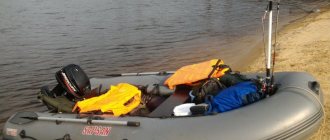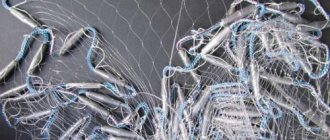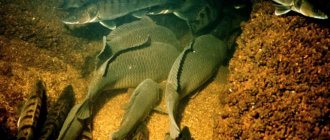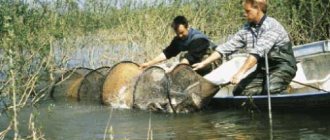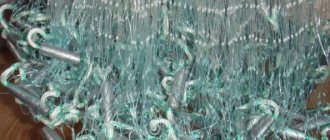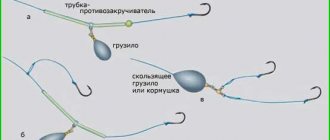The casting net is also known to fishermen as a cover, a cape, a parachute, a mantle, a cape. It may seem strange, but we have very few specialists in this fishing. There are many explanations for this paradox. Since ancient times, fishing with a casting net has been traditional among southern countries. Fishermen who have been fishing with a parachute since childhood achieved amazing results in the future.
It’s rare that a tourist gets to watch a local fisherman throw an incomprehensible package into the water, which unfurls a moment later, turning into a huge round net, and which, upon returning, brings the fisherman a huge catch. Of course, a tourist, like any other person, wants to learn how to fish as well.
The principle of fishing with a casting net
The net must be collected in the hand so that it can easily unfold in flight. Then it is necessary to perform a horizontal throw so that it can cover a section of water corresponding to the diameter of the net. The parachute is pulled out by the cord only after its loaded part has sunk to the bottom. You can also fish with a casting net in the water column; to do this, it is enough not to wait until it touches the bottom, but in this case it is necessary to make a number of changes in its design.
How to cast a casting net correctly
Correct casting of the casting net is the most important and difficult thing in its use. Before throwing your fishing gear into the water, it makes sense to practice and learn all the intricacies on the shore. Naturally, for this you need to choose a convenient site in a field or meadow, having first cleared it of interfering bushes, tall grass and debris. Otherwise, the net will break and there will be nothing to catch. It must be remembered that the technique of casting casting nets of different types differs significantly.
Technique for casting a casting net with a ring
First, let's look at how to cast a casting net with a ring. In this case, it is necessary to take into account certain differences in casting a net with different rings.
Throwing a casting net with a large ring is the simplest and consists of the following:
- We carefully straighten the net on the ground.
- We release the middle ring, as a result the large one goes down to the cargo rope, and the small one presses the net.
- We fasten the loop made at the end of the cord to the belt or put it on the wrist.
- Unwind the traction cord.
- We throw the tackle to the chosen place as if we were launching a flying saucer.
When running such a network, you don't need to turn your body when throwing or have a lot of skill.
The most important and difficult thing is to cast the casting net correctly
When casting casting nets with a small ring, the net is pulled out, causing the ring to press the bag against the rope. This type of casting is somewhat more complicated and is somewhat similar to throwing a Spanish flu.
Technique for casting a Spanish casting net
Now let’s look at how to cast a Spanish-type casting net. Preparing to cast it consists of the following steps:
- The traction rope twisted into rings is taken in the left hand, and the loop at its end is put on the hand or, more securely, attached to the belt.
- With your left hand, grab the net by the center and gently shake it to prevent loops from forming.
- The upper part of the mesh, approximately a third of the radius, is assembled with several loops in the left hand.
- The rope, equipped with weights, is taken in two hands, which we spread widely to stretch the free part of the tackle as much as possible. Sometimes professionals, in order to stretch the net even better, take one weight with their teeth.
Read more
How to properly load a float?
At the moment of throwing, the body must be turned 180ᵒ and with a wide swing, straightening the body, perform the throw. In this case, you should ensure that the tackle flies into the water very gently and turns into a circle just before it touches the water. Sometimes it is recommended to make several swinging movements before throwing. Throwing a large casting net is naturally more difficult, but having practiced on it, it will be much easier to cope with a smaller net.
American-style casting network structure
To have an idea of the casting network, let's take a closer look at the structure of the American-type network, which consists of:
- Setepolono is made from excellent quality monofilament. To give the fishing line strength and softness, it is treated with a special coating. In order for the net to be able to open to its maximum width, it is stretched in production;
- A weight cord which consists of two braided polyethylene cords of smaller diameter twisted together, thereby providing increased wear resistance and strength. The connection of the sinkers occurs at the moment the catch is pulled ashore, thereby forming a bag in which the entire catch is located;
- Additional lacing with the help of which ensures a strong connection of the cargo cord with the loads. By weaving the cord three times, it allows you to secure the casting net from below;
- Sinkers weighing 26 grams are made of lead;
- The carabiner performs a protective function, preventing the cord from twisting;
- A horn designed for more convenient casting of the net. Made of composite material, it is located inside the network, making it easy to assemble. Usually the horn is connected to the net using high quality glue;
- Line veins designed for casting with a lower weight cord. The veins are made of thick monofilament fishing line. While pulling the casting net, they tighten the net, thereby forming a bag with a closed mouth. The fish finds itself in a trap and can no longer get out. Thanks to the veins of thick monofilament fishing line, the entire network receives additional strength;
- The casting cord is made of polyethylene, a material that has increased buoyancy and does not absorb water. Thanks to its large length reserve, it allows you to use the net for fishing at great depths, as well as casting from a pier, shore, or boat;
- Loops located at the end of the casting cord. The fisherman fixes it on his wrist while casting the net. The loop has a tight weave.
At the moment there are two large groups of casting networks: Spanish and American. For casting, nets from the American group are more convenient; they are easy to make yourself, and they are known for their effectiveness. The Spanish group of nets have one small advantage: they can be used to fish areas of a reservoir with inconvenient terrain, as well as driftwood, stones, etc.
Casting fishing nets
Content
Fishing with a cast net, also called a parachute net, a cape net, etc., is one of the traditional fishing methods, typical for Asian and South American countries. In our area it is not very common, although many, looking at the high catchability of the gear and its apparent simplicity, would like to learn how to work with it. Learning to properly use such a network is a rather painstaking and time-consuming process, but anyone can master this art if they wish.
The essence of fishing is as follows:
- the net is wound around the hand in a special way and thrown to the chosen place;
- there it opens, covering a certain area of water;
- its loaded part sinks to the bottom, forming a dome;
- a few seconds after casting, pulling the rope tied to the base, the angler tightens the loop;
- the fish that was under the net ends up in a kind of bag or pocket, and the net is raised to the surface.
There are two main types of casting nets, differing in their design and technique of use - American and Spanish.
American and Spanish are the two main types of casting networks
American type casting network
An American casting net with a ring is a round net, along the outer edge of which a nylon cord with lead weights is threaded. There is a hole in the center of the circle with a ring attached.
The outer circumference of the net and the central ring are connected by slings. At the top, the lines are passed through the hole and attached to the ring. The ring is connected with a swivel to a traction cord, which is designed for casting and retrieving the tackle.
When the net is pulled out of the water, the traction rope with the help of slings pulls the cord equipped with weights to the central part, and the net is tightened and creates a compact bag with no escape for the fish trapped inside.
There are two types of American net - with a large and small ring.
Fishing with a casting net with a large ring
An American type casting net with a large ring is also called a Frisbee. It is usually equipped with three rows of rings. A casting net with a large double ring is also often used.
The American casting net with a large ring is the easiest to cast and retrieve. During flight, it is guaranteed to open without tangling the lines.
The easiest to cast and retrieve is the American casting net.
Small ring casting net
A casting net with a small ring resembles a Spanish flu. When pulled, the small ring tightens the net and presses it against the rope. This cape can be used in harsher conditions than a frisbee. It works well even in strong gusts of wind, when other networks cannot cope.
The choice of the possible diameter of an American casting net with a small ring is directly related to the height of the fisherman:
- if the fisherman’s height is up to 145 cm, then he will be able to use a net whose diameter does not exceed three meters;
- with a height of 170 cm, you can choose a net with a diameter of up to three and a half meters;
- height exceeding 180 cm allows you to work with any networks, including four-meter ones.
Read more
What does it consist of and how to make bait for roach?
Spanish type casting network
The main differences between the design of the Spanish casting network and its American counterpart are as follows:
- lack of slings;
- attaching the traction cord directly to the central part of the network;
- the location of the weights at some distance from the edge of the network.
These differences affect the behavior of the network as a result of abandonment. When pulling a casting net without a ring, the sinkers, under the influence of their weight and the tension of the rope, gather towards the center. This covers the exit for fish, which fall into pockets formed around the perimeter.
The Spanish type casting net is characterized by the absence of slings
Network design
The casting network has the following design:
- Network fabric in the shape of a circle of the correct diameter;
- A cord located along the edge of the canvas and equipped with small, often set lead weights;
- Quite thick braided central cord;
- A loop.
Each group of casting nets has slight deviations from the standard design type. For example, in American-type nets, the other end of the central cord can be attached to slings stretched to the cargo cord, and in Spanish nets, to the center.
In American-type nets, the central cord, with the help of veins, pulls the load cord to the center, thereby giving the net the shape of a bag with a tightly closed neck. Spanish nets, on the contrary, when pulled out, form, due to their own weight and the location of the central cord, pockets in which the entire catch is located.
See also: Why is it cold in thermal underwear? Let's find out the reasons!
American networks are equipped with a small round hole in the very center of the network fabric; a fluoroplastic or plastic sleeve is attached to the edge of the hole. The sleeve also has one or more holes designed for sliding slings, the number of holes depends on the dimensions of the network. The cells of the mesh fabric should be small in size and consist of twisted or monofilament.
Design features of the gear
As for the design of the casting net, it consists of a net fabric in the shape of a regular circle, the edge of which is lined with a cord with fairly heavy weights. The network is pulled out using a central braided cord (twisted versions cannot be used) with a fairly large thickness, usually 5-6 millimeters. The length of this cord is 4-4.5 m, although most anglers double it over time. The end of the cord is equipped with a loop with a diameter of 20-25 centimeters.
Read Fishing for rudd
In the American version, the central cord is attached at the other end to various slings that are pulled to the load cord. In Spanish models it is fixed to the central part of the network. It is this feature that distinguishes gear, determining different principles of operation.
When pulling out the American cape, the cargo cord is pulled up through the veins, which is necessary to collect the device into a compact lump, from which there is no exit for the fish. When the Spanish net is pulled out, all the sinkers move to the central part, and under the influence of their own gravity they close the exit.
In American models, a small round hole is made in the central part, the diameter of which is 5-6 centimeters. The mesh fabric is fixed at the edges to a sleeve made of plastic or fluoroplastic.
A few tips for making your own American-style casting net
Those wishing to make an American-style casting net must adhere to several rules:
- Slings or wires must be made of fishing line, their thickness should be more than 1 mm, and their length should slightly exceed the radius of the network. The wires need to be attached to the weight cord quite often. If the plastic sleeve has not one, but several holes, then veins are passed through each, which lead to the corresponding edge of the network; it is important to prevent crossing. It is also advisable not to leave burrs, sharp edges or other irregularities on the edges of the holes;
- Sinkers must be evenly placed on the load cord, the minimum distance between the centers of which should not exceed 12 cm. Depending on the dimensions of the net, the weight of the sinkers is selected; it should not be less than 20 and more than 35 grams. The most optimal are sinkers in the shape of a strongly elongated cylinder; it is highly not recommended to use spherical sinkers. If it is possible to cast the weights yourself, it is important to carefully process each weight and eliminate any unevenness and burrs;
- Particular attention should be paid to the formation of a node that collects the veins. Ideally, it should be neat, compact and without fishing lines sticking out in all directions.
The most optimal net sizes for beginners in fishing using a casting net
Unfortunately, there is no consensus on choosing the most optimal network size for beginners. Some people advise first to try fishing with a smaller diameter net, which makes casting easier.
Others advise immediately training on professional nets, since, having mastered a three-foot net, it is quite difficult to switch to a net of a larger diameter. Also, the choice of net size directly depends on the physical characteristics of the fisherman; the taller the height and longer the arms, the easier it is for him to work with a large-sized net.
Before you start learning to fish using a casting net, it is important to determine exactly the purpose of its use. Fans of predator hunting should definitely keep a casting net on hand as an indispensable auxiliary tool.
A tool in the form of a net is truly irreplaceable, as it allows you to quickly catch the amount of live bait necessary for catching a predator. For these purposes, you can purchase a regular three-foot casting net. In other cases, it is better to immediately begin developing networks with a diameter of 1.7 - 2 meters.
Casting technique
It is recommended to start training on a mowed lawn or lawn. In the future, before casting, the nets must first be cleaned of mud and other lake dirt. Now you can start casting.
First, you need to collect the traction cord in rings in your left hand. Then, with your free outstretched hand, you need to grab and shake the net so that it is well straightened and stretched. It is also important to ensure that the weight cord does not form a loop anywhere.
Next, with the right hand, the tackle is intercepted and collected in rings in the left hand. Take the weight cord by two points with your left and right hands and stretch the net to the maximum possible distance.
Now you can start casting by performing two or three swinging movements or one wide swing, while trying to turn the body 1800. When performing a cast, it is important to take into account the plane of movement of the net.
When turning around, it should fly along the flattest trajectory and touch the water, turning around completely. Successful casting directly depends on the correct measurement of the force required for the throw.
Before you start casting, it is important to wrap the loop not on your left hand, but on your waist belt to prevent it from slipping out during casting.
The casting technique described above is not the only one. Having trained, the catcher over time begins to modernize and adjust the casting technique to suit himself, taking into account the peculiarities of fishing and individual characteristics.
Using nets with a radius of 1.7 to 2 meters, the fisherman does not have to collect the upper part of it into loops. Then you need to take the load cord in your hands, and placing them as wide as possible, throw the nets into the pond. In this case, the excess cord should be wound in rings on each hand, and during casting the fisherman should, as it were, “cover the table with a tablecloth.”
See also: How to make fishing leashes?
The most optimal place for fishing with a casting net
When deciding to go fishing with a casting net, it is better to avoid areas with a snagy bottom, abundant vegetation, fast currents and boulders. You should also not look closely at the “edges,” the so-called steep underwater slopes; this area will also not allow you to catch the fish that live in those parts.
If you decide to fish with a casting net from the shore, it is recommended not to choose places with bushes, trees, or annual vegetation. The ideal would be a flat and clean area of the reservoir of about a couple of meters.
Moreover, you should not look for the meaning of fishing from cliffs, bridges and embankments that rise above the water by more than 2 meters. Even correctly cast casting net sinkers from this distance will cause the sinkers to converge, thereby deforming the net from an even circle into an elongated cone. It is best to fish with a net in well-known places to avoid snags or other damage to the net.
Which casting network to choose
Many people ask which casting network is better. But there is no clear answer to this question. It all depends on the purpose of its use and the fishing conditions. If you plan to use a net to provide yourself with live bait, the cell size should not exceed one centimeter. Fishing with a casting net at sea involves using an American net with a small ring, since a frisbee will not be effective in strong gusts of wind.
Read more
What is a fishing spider?
To determine which casting network to choose: American or Spanish, let’s consider their features.
The first has the following advantages:
- ease of throwing;
- high catchability;
- increased reliability and strength;
- comparative ease of self-production.
The main advantage of the Spanish fluke is the ability to use it in reservoirs with difficult terrain and a cluttered bottom, since it is less prone to snags.
Which casting network to choose: American or Spanish, there is no definite answer
The choice of the diameter of casting nets with a large ring does not depend on the height of the fisherman, but on the purpose of using the gear. But for other types of casting net, its diameter significantly affects the difficulty of casting.
For beginners, of course, it is easier to cast a smaller net, but you need to keep in mind that retraining to use larger nets is more difficult than vice versa. Therefore, when choosing the size of gear, it is better to initially buy exactly the option that the angler intends to use in the future. Moreover, if a fisherman knows how to work with a four-meter net, it is quite easy for him to master the art of casting smaller specimens.
Catching live bait using a casting net
Catching small fish with a casting net is quite easy and simple. The main thing in this matter is the correct time and place of fishing. Having spotted the habitat of small schools of perch or roach, you can safely begin casting the net. Thanks to the presence of a casting net, a boat or wading fishing is not required to catch live bait. With just one successful cast, you can send dozens of small fish into the bucket. But now you can start catching larger fish.
Catching large fish using a casting net
It is best to catch large fish with a casting net blindly. You shouldn’t try your luck in catching fish in shallow water; remember, if you see the fish, then it sees you too.
Having made even the most accurate cast, the fish will not allow itself to be caught, it will simply retreat to the side. In spring, it is recommended to fish in front of any natural obstacle, the main thing is that the bottom is flat and the depth is approximately 1.5 meters.
Casting should be carried out in the same way as with a spinning rod. First of all, it is necessary to “probe” areas located close to the fisherman, then areas of medium distance, and, lastly, the most distant ones.
Don’t worry, using a casting net, this way you won’t be able to scare away the fish, it can only roll a little lower, the main thing is to make the right casts. Therefore, initially the territory located from the shore is fished and goes downstream.
In the spring, it is recommended to use a net for daytime fishing, but towards the end of summer, fishing in the twilight and at night is considered effective. Do not forget that in summer aquatic vegetation appears in a reservoir in huge quantities, which significantly reduces the number of places that can be used for blind fishing. In this case, you can switch to hunting for single specimens of fish.
Promising place for fishing
It is useless to start fishing in places that are too deep, where there is a fast current. It is better to avoid areas with snags or abundant vegetation, steep underwater edges and other obstacles. If you are fishing from the shore rather than from a boat, it is best to avoid areas with too many trees and bushes, as well as various annual vegetation, including sagebrush and weeds.
Read How to fry river fish in a frying pan
Fishing is ineffective from cliffs and embankments of bridges that rise more than two meters above the water surface. When fishing in unknown places, the risk of snags and damage to the net increases.
After the cord with the load is at the bottom, the tackle must be selected with sharp jerks. With their help, you can quickly bring the sinkers together and close the exit for the caught prey. The net also needs to be raised above the bottom to minimize snags.
Catching live bait and any other small prey in this way is very simple. All that is required of the fisherman is to correctly select a promising area and perform an accurate cast. In most cases, small fish are found in large schools, so you can get a huge number of fish from the depths at one time. It is not necessary to use a floating device for such purposes; it is much more convenient to cast the tackle from the shore.
Large representatives lead a solitary lifestyle, preferring areas remote from the coastal zone, where there are snags, stones and other obstacles. To catch them you need to put in a lot of effort and effort.
Fishing with a casting net is a really interesting, and for some, a new activity that requires proper preparation and effort. A responsible approach and adherence to the basic rules will allow you to achieve good results in this difficult but exciting task.
Catching pike using a casting net
It is best to catch pike from a boat. On hot summer days, she prefers to hunt in channels and small creeks overgrown with vegetation. The most effective fishing for pike is during the spawning season, it is then that it forgets about caution and can let the fisherman get closer.
The only thing that can interfere is vegetation, which is where hunters usually spawn. The reason is that the net, once on vegetation, may not completely close, releasing the prey into the wild.
However, having made a successful cast, the fisherman often manages to catch two or even three males and one female. Quite often, predator spawning sites are determined by splashes or by the movement of the stems of aquatic plants. Remember that you need to go after such a cautious predator as pike with the utmost caution.
Source
